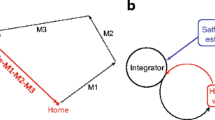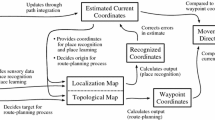Abstract
Many animals can return home accurately after exploring for food using their own homing navigation algorithm. Path integration plays a critical role in homing navigation. It is believed that animals are able to recognize their relative location from the nest by accumulating both distance and direction experienced during their travel. We tested possible patterns of neuronal organization for a path integration mechanism. The neural networks consisted of a circular array of neurons, following population coding. We describe here a neural model of path integration involving a relatively small number of neurons and discuss how well the model operates for homing navigation. Robotic simulations suggest that a neural structure with only a few sensor neurons can successfully handle the path integration needed for homing navigation.
Similar content being viewed by others
References
Mittelstaedt H (1983) The role of multimodal convergence in homing by path integration. Fortschr Zool 28: 197–212
Wehner R, Wehner S (1990) Insect navigation: use of maps or Ariadne’s thread?. Ethol Ecol Evol 2: 27–48
Zeil J, Hemmi J (2006) The visual ecology of fiddler crabs. J Comp Physiol A 192: 1–25
Layne JE, Barnes WJ, Duncan LM (2003) Mechanisms of homing in the fiddler crab Uca rapax, 1. Spatial and temporal characteristics of a system of small-scale navigation. J Exp Biol 206: 4413–4423
Dudchenko PA, Bruce C (2005) Navigation without landmarks: can rats use a sense of direction to return to a home site?. Connect Sci 17(1–2): 107–125
Kimchi T, Etienne AS, Terkel J (2004) A subterranean mammal uses the magnetic compass for path integration. Proc Natl Acad Sci USA 101: 1105–1109
Wehner R (2003) Desert ant navigation: how miniature brains solve complex tasks. J Comp Physiol A 189: 579–583
Wehner R, Michel B, Antonsen P (1996) Visual navigation in insects: coupling of egocentric and geocentric information. J Exp Biol 199: 129–140
Wittmann T, Schwegler H (1995) Path integration—a network model. Biol Cybern 73: 569–575
Kubie JL, Fenton AA (2009) Heading-vector navigation based on head-direction cells and path integration. Hippocampus 19: 456–479
Ranck JB Jr (1985) Head direction cells in the deep cell layer of dorsal presubiculum in freely moving rats. In: Buzsaki G, Vanderwolf CH (eds) Electrical activity of the archicortex. Hungarian Academy of Sciences, Budapest, pp 217–220
Taube JS, Muller RU, Ranck JB Jr (1990) Head-direction cells recorded from the postsubiculum in freely moving rats. I. Description and quantitative analysis. J Neurosci 10: 420–435
Kim D, Hallam JCT (2000) Neural network approach to path integration for homing navigation. From Animals to Animats 6:228-235 MIT Press, 2000
Loffler A, Klahold J, Ruckert U (2001) The mini-robot Khepera as a foraging animate: synthesis and analysis of behavior. Auton Minirobots Res Edutainment AMiRE 97: 93–130
Kim D (2006) Neural network mechanism for the orientation behaviour of sand scorpions towards prey. IEEE Trans Neural Netw 17(4): 1070–1076
Haykin S (1999) Neural networks, a comprehensive foundation. Prentice Hall Inc, New York
Koch C (1999) Biophysics of Computation. Oxford University Press, New York
Gabbiani F, Krapp HG, Koch C, Laurent G (2002) Multiplicative computation in a visual neuron sensitive to looming. Nature 420(6913): 320–324
Georgopoulos AP, Kalaska JF, Caminiti R, Massey JT (1982) On the relations between the direction of two-dimensional arm movements and cell discharge in primate motor cortex. J Neurosci 2(11): 1527–1537
Lewis JE (1999) Sensory processing and the network mechanisms for reading neuronal population codes. J Comp Physiol A 185: 373–378
Seung HS, Sompolinsky H (1993) Simple models for reading neuronal population codes. Proc Natl Acad Sci USA 90: 10749–10753
Redish AD, Touretzky DS, Wan HS (1994) The sinusoidal array: a theory of representation for spatial vectors. In: Eeckman FH (eds) Computation in neurons and neural systems. Springer, Berlin, pp 269–274
Seguinot V, Cattet J, Benhamou S (1995) Path integration in dogs. Anim Behav 55: 787–797
Müller M, Wehner R (1988) Path integration in desert ants. Cataglyphis fortis, PNAS 85(14): 5287–5290
Author information
Authors and Affiliations
Corresponding author
Rights and permissions
About this article
Cite this article
Kim, D., Lee, J. Path Integration Mechanism with Coarse Coding of Neurons. Neural Process Lett 34, 277–291 (2011). https://doi.org/10.1007/s11063-011-9198-5
Published:
Issue Date:
DOI: https://doi.org/10.1007/s11063-011-9198-5




